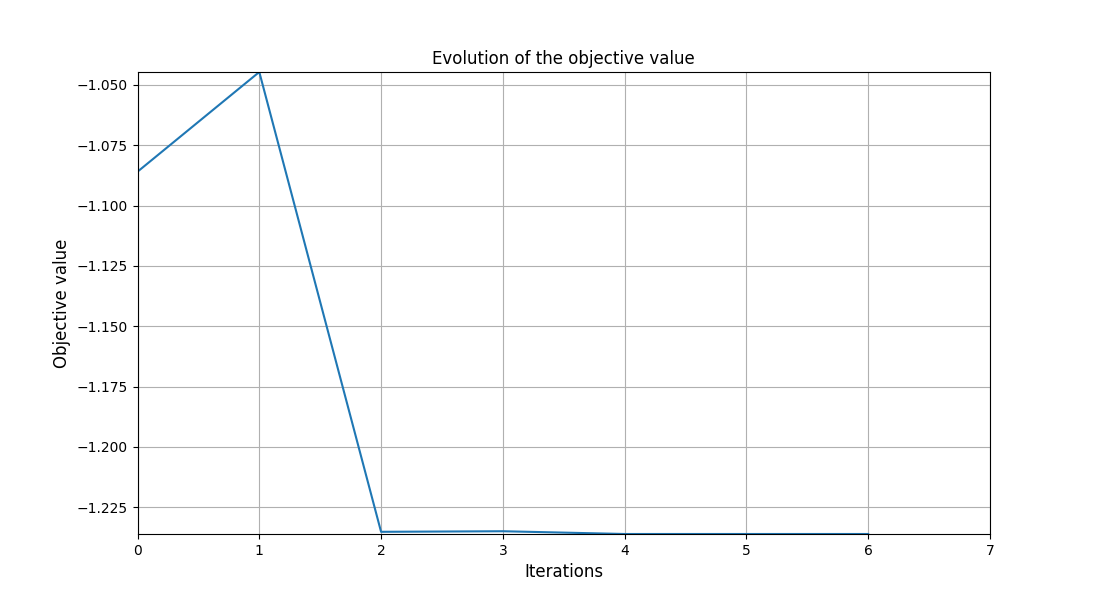Note
Click here to download the full example code
Analytical test case # 2¶
In this example, we consider a simple optimization problem to illustrate algorithms interfaces and optimization libraries integration.
Imports¶
from __future__ import absolute_import, division, print_function, unicode_literals
from future import standard_library
from numpy import cos, exp, ones, sin
from gemseo.algos.design_space import DesignSpace
from gemseo.algos.doe.doe_factory import DOEFactory
from gemseo.algos.opt.opt_factory import OptimizersFactory
from gemseo.algos.opt_problem import OptimizationProblem
from gemseo.api import configure_logger, execute_post
from gemseo.core.function import MDOFunction
configure_logger()
standard_library.install_aliases()
Define the objective function¶
We define the objective function \(f(x)=sin(x)-exp(x)\)
using a MDOFunction defined by the sum of MDOFunction objects.
f_1 = MDOFunction(sin, name="f_1", jac=cos, expr="sin(x)")
f_2 = MDOFunction(exp, name="f_2", jac=exp, expr="exp(x)")
objective = f_1 - f_2
See also
The following operators are implemented: addition, subtraction and multiplication. The minus operator is also defined.
Define the design space¶
Then, we define the DesignSpace with GEMSEO.
design_space = DesignSpace()
design_space.add_variable("x", 1, l_b=-2.0, u_b=2.0, value=-0.5 * ones(1))
Define the optimization problem¶
Then, we define the OptimizationProblem with GEMSEO.
problem = OptimizationProblem(design_space)
problem.objective = objective
Solve the optimization problem using an optimization algorithm¶
Finally, we solve the optimization problems with GEMSEO interface.
Solve the problem¶
opt = OptimizersFactory().execute(problem, "L-BFGS-B", normalize_design_space=True)
print("Optimum = ", opt)
Out:
Optimum = Optimization result:
Objective value = [-1.23610834]
The result is feasible.
Status: 0
Optimizer message: b'CONVERGENCE: NORM_OF_PROJECTED_GRADIENT_<=_PGTOL'
Number of calls to the objective function by the optimizer: 8
Constraints values:
Note that you can get all the optimization algorithms names:
algo_list = OptimizersFactory().algorithms
print("Available algorithms ", algo_list)
Out:
Available algorithms ['NLOPT_MMA', 'NLOPT_COBYLA', 'NLOPT_SLSQP', 'NLOPT_BOBYQA', 'NLOPT_BFGS', 'NLOPT_NEWUOA', 'SLSQP', 'L-BFGS-B', 'TNC']
Save the optimization results¶
We can serialize the results for further exploitation.
problem.export_hdf("my_optim.hdf5")
Post-process the results¶
execute_post(problem, "OptHistoryView", show=True, save=False)
Out:
/home/docs/checkouts/readthedocs.org/user_builds/gemseo/conda/3.0.3/lib/python3.8/site-packages/gemseo/post/opt_history_view.py:312: UserWarning: FixedFormatter should only be used together with FixedLocator
ax1.set_yticklabels(y_labels)
<gemseo.post.opt_history_view.OptHistoryView object at 0x7fc299ce4040>
Note
We can also save this plot using the arguments save=False
and file_path='file_path'.
Solve the optimization problem using a DOE algorithm¶
We can also see this optimization problem as a trade-off and solve it by means of a design of experiments (DOE).
opt = DOEFactory().execute(problem, "lhs", n_samples=10, normalize_design_space=True)
print("Optimum = ", opt)
Out:
Optimum = Optimization result:
Objective value = [-5.34787154]
The result is feasible.
Status: None
Optimizer message: None
Number of calls to the objective function by the optimizer: 18
Constraints values:
Total running time of the script: ( 0 minutes 0.607 seconds)



